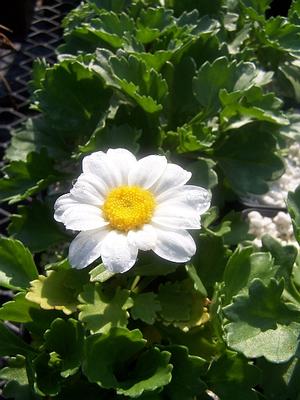Printed at http://www.quackingrassnursery.com/index.cfm/
Chrysanthemum yezoense
Hardy Mum
Plant Type:
SUN PERENNIALSChrysanthemum yezoense (ex: Jonathan Lehrer) – This rhizomatous species mum forms a most handsome ground cover of handsome, deep green scalloped leaves above which pristine white daisies with a yellow button center are raised just above the mat of folaige. They begin flowering in Summer and in a climate warmer than our own may bloom beyond Thanksgiving. It is charming. As flowers age they may pick up some pink to purple infusion. This another plant that will extend the late gardening season for all of us interested in doing so. Let it form a mat before, between and around other sun lovers. Site Chrysanthemum yezoense in full to part sun planted in any good garden soil that drains. This will be fantastic late season interest as a border edging or even potted. All of our mum selections are propagated by cuttings and are pot-grown.
We strongly recommend spring planting in colder regions so that the plants will be well-established by the time cold weather arrives. Cut them back to a lower leaf axil by mid-July in the north, earlier farther south; doing so will result in better-branched plants on a more compact habit adorned with even more flowers at season’s end. But if you don’t, regardless, you’ll have multitudes of flowers on longer stems but possibly more decumbent plants. Plant all mums in full to part sun in fertile draining soil. Honeybees love them as this is one of the last flowering perennials to bloom in such abundance in the autumn in New England, along with some of the later asters.
Characteristics and Attributes for Chrysanthemum yezoense
Season of Interest (Flowering)
- Autumn
Season of Interest (Foliage)
- Spring / Summer / Autumn
Nature Attraction
- Honey Bees & Native Bees
Light
- Morning Sun / Afternoon Shade
- Full Sun
Attributes
- Rock Garden
- Natural Garden
- Border
- Edging
- Ground Cover
- Wildlife Garden
- Massing
Growth Rate in the Garden
- Moderately Fast
Soil
- Draining
- Fertile
Origins
- Asia
- Japan
Propagated By
- Cutting Grown
Genus Overview: Chrysanthemum
All of our mums are hardy in USDA zone 5. We strongly recommend spring planting in colder regions so that the plants will be well-established by the time cold weather arrives. Cut them back to a lower leaf axil by mid-July in the north, earlier farther south; doing so will result in better-branched plants on a more compact habit adorned with even more flowers at season’s end. But if you don’t, regardless, you’ll have multitudes of flowers on longer stems but possibly more decumbent plants. Plant all mums in full to part sun in fertile draining soil. Honeybees love them as this is one of the last flowering perennials to bloom in such abundance in the autumn in New England, along with some of the later asters. The heights given are flexible, determined by the conditions in which they are planted and if pruned. All of our cultivars are propagated by cuttings and are pot-grown.

